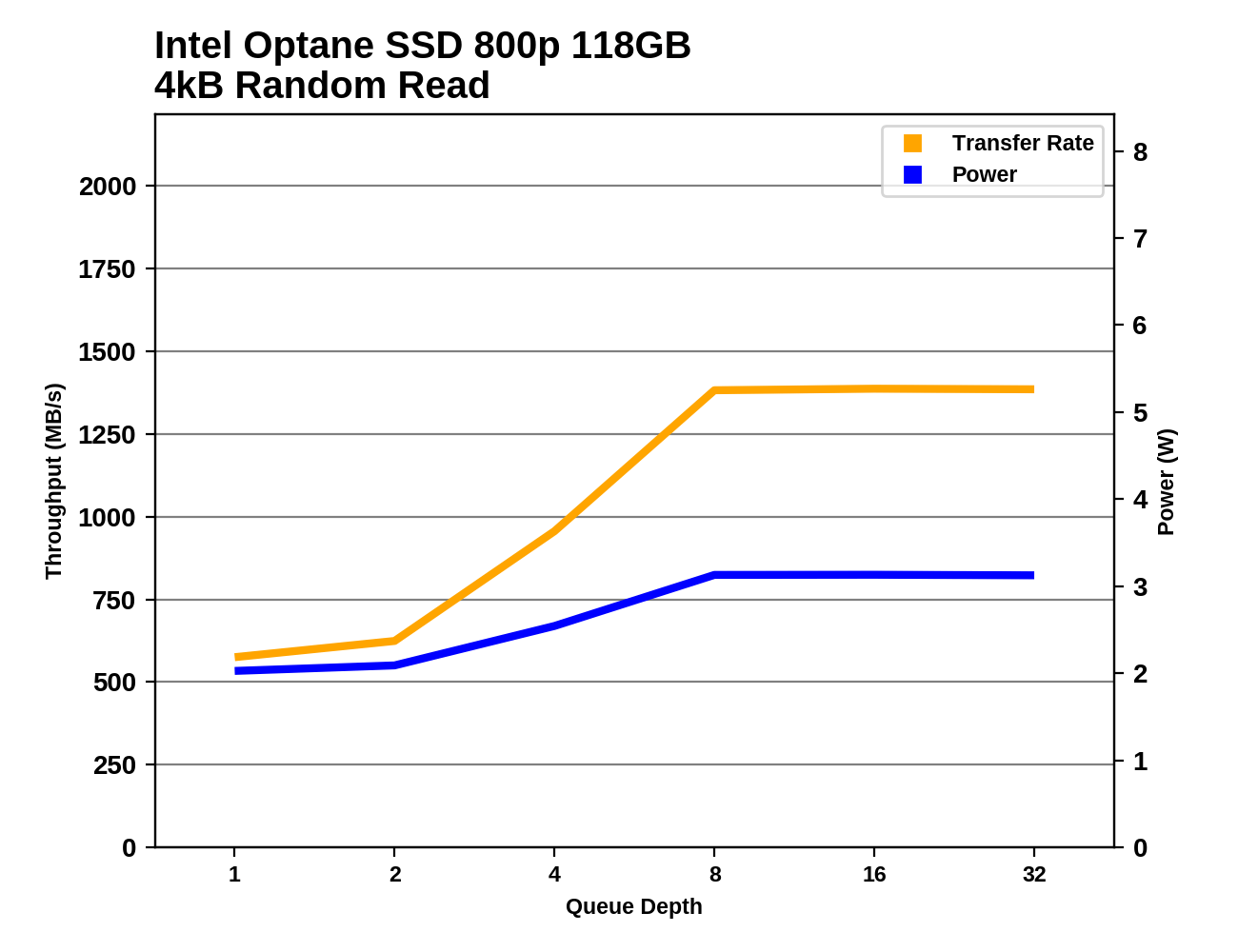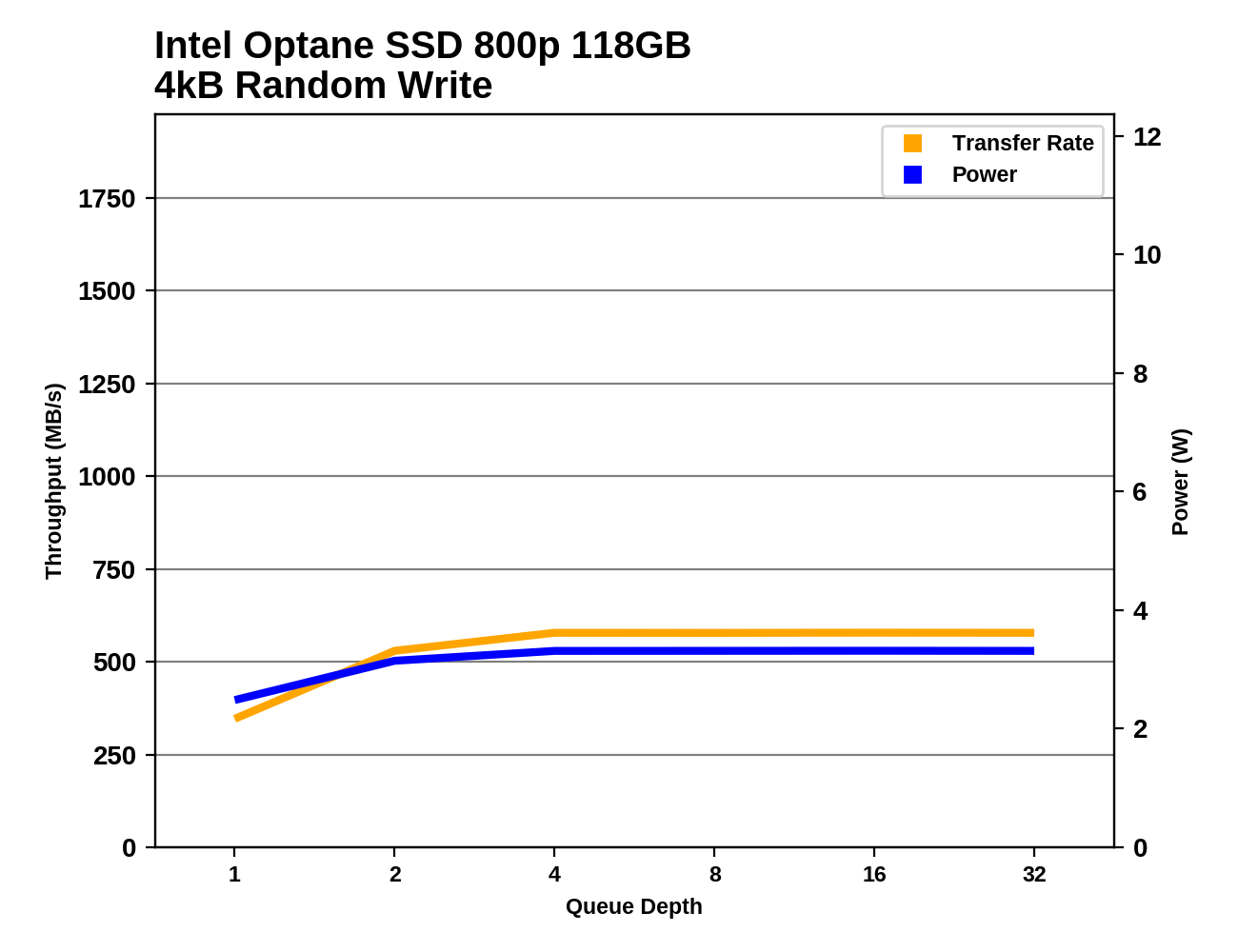The Intel Optane SSD 800p (58GB & 118GB) Review: Almost The Right Size
by Billy Tallis on March 8, 2018 5:15 PM ESTRandom Read Performance
Our first test of random read performance uses very short bursts of operations issued one at a time with no queuing. The drives are given enough idle time between bursts to yield an overall duty cycle of 20%, so thermal throttling is impossible. Each burst consists of a total of 32MB of 4kB random reads, from a 16GB span of the disk. The total data read is 1GB.

Like the Optane Memory M.2, the Optane SSD 800p has extremely high random read performance even at QD1. The M.2 drives even have a substantial lead over the much larger and more power-hungry 900p and its enterprise counterpart P4800X. Even the best flash-based SSDs are almost an order of magnitude slower.
Our sustained random read performance is similar to the random read test from our 2015 test suite: queue depths from 1 to 32 are tested, and the average performance and power efficiency across QD1, QD2 and QD4 are reported as the primary scores. Each queue depth is tested for one minute or 32GB of data transferred, whichever is shorter. After each queue depth is tested, the drive is given up to one minute to cool off so that the higher queue depths are unlikely to be affected by accumulated heat build-up. The individual read operations are again 4kB, and cover a 64GB span of the drive.

The Optane SSDs continue to dominate on the longer random read test, though the addition of higher queue depths allows the 900p to pull ahead of the 800p.

With extremely high performance but lacking the high power draw of the enterprise-class 900p, the Optane SSD 800p is by far the most power efficient at performing random reads.
 |
|||||||||
The Optane SSD 800p starts out in the lead at QD1, but its performance is overtaken by the 900p at all higher queue depths. The flash-based SSDs have power consumption that is comparable to the 800p, but even at QD32 Samsung's 960 PRO hasn't caught up to the 800p's random read performance.
Random Write Performance
Our test of random write burst performance is structured similarly to the random read burst test, but each burst is only 4MB and the total test length is 128MB. The 4kB random write operations are distributed over a 16GB span of the drive, and the operations are issued one at a time with no queuing.

Flash-based SSDs can cache and combine write operations, so they are able to offer random write performance close to that of the Optane SSDs, which do not perform any significant caching. Where the 32GB Optane Memory offered relatively poor burst random write performance, the 800p is at least as fast as the best flash-based SSDs.
As with the sustained random read test, our sustained 4kB random write test runs for up to one minute or 32GB per queue depth, covering a 64GB span of the drive and giving the drive up to 1 minute of idle time between queue depths to allow for write caches to be flushed and for the drive to cool down.

When higher queue depths come into play, the write caching ability of Samsung's high-end NVMe SSDs allows them to exceed the Optane SSD 800p's random write speed, though the 900p still holds on to the lead. The 800p's improvement over the Optane Memory is even more apparent with this longer test.

The power efficiency of the 800p during random writes is pretty good, though Samsung's top drives are better still. The Optane Memory lags behind on account of its poor performance, and the 900p ranks below that because it draws so much power in the process of delivering top performance.
 |
|||||||||
The Samsung 960 PRO and the Intel Optane SSD 900p show off at high queue depths thanks to the high channel counts of their controllers. The Optane SSD 800p doesn't have much room for performance to scale beyond QD2.










116 Comments
View All Comments
0ldman79 - Thursday, March 8, 2018 - link
That is a pretty significant limitation.With SSD's a lot of us have small to mid sized SSD as a boot drive and practically everything else resides on a spinner.
If Optane can't cache the secondary drive then it is of less use to me than even the Kaby Lake and above limitation. That means that even if I built a Kaby Lake or Coffee Lake I still won't get any benefit on the anything aside from the OS. My games are all installed on a mechanical drive.
Lolimaster - Friday, March 9, 2018 - link
Crucial MX500 2TB $499If you're an avid GTAV player, the 118GB should be a nice thing for the game intall, also your pagefile and install/profile/cache of firefox/chrome.
TheWereCat - Friday, March 9, 2018 - link
Micron 1100 2TB $370https://www.amazon.com/gp/aw/s/ref=is_s_ss_i_1_9?k...
Reflex - Friday, March 9, 2018 - link
Yup, grabbed one of those a few weeks ago, its a great drive for that price.hescominsoon - Friday, March 9, 2018 - link
I run only a micro 1TB ssd in my machine for everything. I have a couple of friends who are into video editing and they use a spinning disk for temporary storage...but that's about it..:)name99 - Friday, March 9, 2018 - link
Any decent SSD that wants to boost itself with a cache can ALREADY do so by using some of the MLC or TLC flash as SLC. And thereby run faster than Optane. And without requiring a separate controller and a separate Optane die.Optane is not buying you anything in the sort of market you describe.
Gunbuster - Thursday, March 8, 2018 - link
Capacity is still useless for any power user who would be shopping this.iter - Thursday, March 8, 2018 - link
It will be useful for pagefile spillover in case you have workloads that require more than the 32 or 64 gb of ram that most high end desktops come with.It will still massacre performance if you go paging, but it will be significantly better than nand, god forbid hdd.
jospoortvliet - Friday, March 9, 2018 - link
That's an interesting use case, the first I read that seems reasonably useful... But it would still need more performance to really make it worth it, and even then only when you don't care about costs at all and your platform simply doesn't support more ram. I mean, as long as the system can handle another ram dimm, you'd go for that even with the insane prices atm...iter - Saturday, March 10, 2018 - link
The thing is many systems can't. 64 is currently a limit for high end, 128 for HEDT.It could get better by raiding more drives, but .... that's not an option on high end platforms due to the low PCIe lane count. You will have to give up on running a GPU if you want to snap in 4 of those drives.